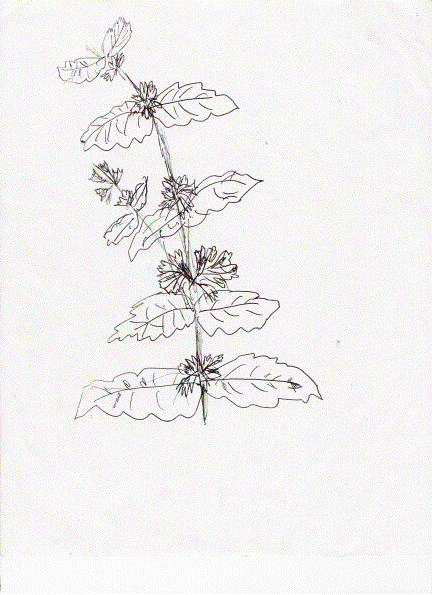Plant Study
LEMON BALM
Family Name: Mint family
Family Name: Lamiaceae/Labiatae
Latin Name: Melissa Officinalis
Common Names: Lemon balm, Balm, Mint, Blue balm
Body System Affiliations:
1. Nervous system
Botanical Description:
Habit: Herb,
Size: 10 inches and reaches up to 1.3meters
Arrangement: Opposite pairs
Leaves: They are bright green .They are ovate and serrate,
Flowers: blossoms are from white blossoms in the summer.
Fruit: All flowering plants have fruits
Bark: the whole plant has fine hairs and a lemony scent when crushed
Ecology:
Habitat: Plenty of sun and water. If it has too much sun the leaves will get scorched. Prefers damp soil with sun to wet and sunny.
Range: It sometimes grows wild in sunny fields and along road sides
Native Where: is mainly southern Europe and North Africa.. Now grows practically every where.
Ecological Relationships: If any discovered
Places/Dates Observed/Description: October29,2005 AT the Skokomish garden at the Native American reservation, Garden of Mylee on evergreen campus.
Plant Part: Leaves
Season of Harvest: Lemon Balm is harvested is harvests in late summer early autumn or twice a week.
Method of Harvest: picking the leaves
Ecological Considerations of Harvest: an acre may produce 1000 pounds or more of dried herb.
Cultural Considerations of Harvest: although lemon bam dries quickly it will not be as fragrant dried as fresh.
Cautions: be careful not to bruise the leaves during harvesting and drying operations as quality will be reduced. (1.)
Indigenous and Non-Western Use/Significance/Relationships:
Materials/Technology: Native Americans have used stems of this plant to wash their hair and make it shiny(3.)
Indigenous Group: African and Ancient Greeks, Native Americans
Part Used: leaves
.
Indications: The herb was applied to wounds or swallowed to help sooth and heal them, also used in the ' middle ages to soothe tension, dress wounds, and as a cure for a toothe ache, skin eruptions, mad dog bites, crooked necks, and sickness during pregnancy. It was even said to prevent baldness, charms.(2) pg33
Body System Associations: Skin
Other: 11 th century Arab herbalist said " it causes the mind and heart to be very merry".
Western (European-American) Uses/Relationships:
Food: Soups and Teas, Salads.
Materials/Technology: ladies made linen or silk amulets as lucky charms out of lemon balm(2) pg33
Medicine:
Part Used: Leaves
Body System Associations: Nervous system
Harvest: July-August
:
Essential Oil Information:
Essential Oils: Citral, Linalool, Geranial, Citronellal, Piper tone, methone, cryophyte, Len oxide
Aromatherapy: calming, healing
Personal Experience:
Food: Salad, Soup and tea
Medicine:
Part Used: The part I used a small amount of leaves and some stem for the soup and it went along way.
Medicinal Actions: I felt feelings of rejuvenation and longevity.
Indications: Having had a long day of work wanting something relaxing and craving for something soul nourishing
Body System Associations: central nervous system
Constituents:
Harvest:
Site Location: garden in Olympia, Washington near the Evergreen state college.
Site Description: The Garden was owned by Mylee, the soil seemed to be fairly damp air quite cold being the middle of fall, with a good source of natural light. I got a branch with about 10 pairs of leaves. There were other herbs such as Rosemary and others I forget. I was told There have been dear and raccoons near the premises pecking at the other plants but I don't think they went after the Lemon Balm. I picked Lemon Balm cause I have heard it being used in many things but I had never used it and knew very little about it.
Technique; Cut a branch of the plant and wrapped it in a wet napkin and put it in a zip lock bag to keep it fresh.
Processing
Storage kept it in the fridge not sure if that was such a good idea it stayed semi moist but it turned black.
Experience; I had a great experience!!I love the taste the experimental aspect and the effects of the actual product.
Application/Preparation/Pharmacy:
Applications [what you made] I made a curry soup, tea, and salad.
Preparation - Curry Soup
I made the soup by first putting in chopped carrots and butternut squash, garlic with oil and curry paste and until they simmer, then I added about 5 leaves of the lemon balm and 2 cups of water, after the vegetables are soft I added cocoanut milk , and when served I added a table spoon of yogurt to my bowl to cool.
Pharmacy [only a few leaves needed
Reason/Purpose My hopes for using it were to feel healthy and relaxed!
Experience It really worked I loved the taste and feeling of warmth comfort and relaxation.
This is a drawing I did of the lemon Balm that I harvested from Mylee's Garden

References Cited:
1.Bergeron, Karen , Alternative Nature Online,37178 Tennessee visited 0ct 29,2005
2.Davis, Jenine, Extension of horticultural Herbalist, north Carolina co.
3.Steven foster and James A. Duke: A Field Guide to Medicinal plants:
Eastern and Central North America Boston; Houghton Mifflin Co.1990
www. The baken.org/about-us/plant.html
Jaimie Terada - Arts Environment and the Child - Fall - 2005